The Allianz Arena will host the inaugural fixture of the new Bundesliga season between Bayern Munich and Schalke 04 on 18 September. This tactical analysis will take a look at how the two teams will face up against each other.
Bayern Munich, led by Hansi Flick, finished the Bundesliga previous season as the righteous champions, after a stellar second half of the campaign which saw them overtake RB Leipzig and create a sizeable points gap. Altogether, they dropped just a single point since the turn of the year, a 0-0 draw against Julian Nagelsmann’s Leipzig. DFB Pokal and Champions League final victories made the Bavarians well-deserved treble winners, especially after their infamous 8-2 win against Barcelona in the semi-final. In this analysis, we will detail Flick’s tactics across his Munich tenure so far, and how they will use them to take the three points against Schalke.
Schalke, managed by David Wagner, led his side a 12th placed finish after his side after winning none of their last 16 matches. If it were not for their impressive start to the campaign, relegation worries would have loomed over the club and its fans. Financial concerns have taken a full grasp of the club, partly due to the ongoing pandemic, and this has seen the sale of Weston McKennie and the potential sale of Ozan Kabak, with the only arrival being 36-year-old Vedad Ibišević on a free transfer. This analysis will take a deeper dive into how Wagner sets his team up and in what manner this could aid them in this matchup against Bayern.
Predicted Lineups
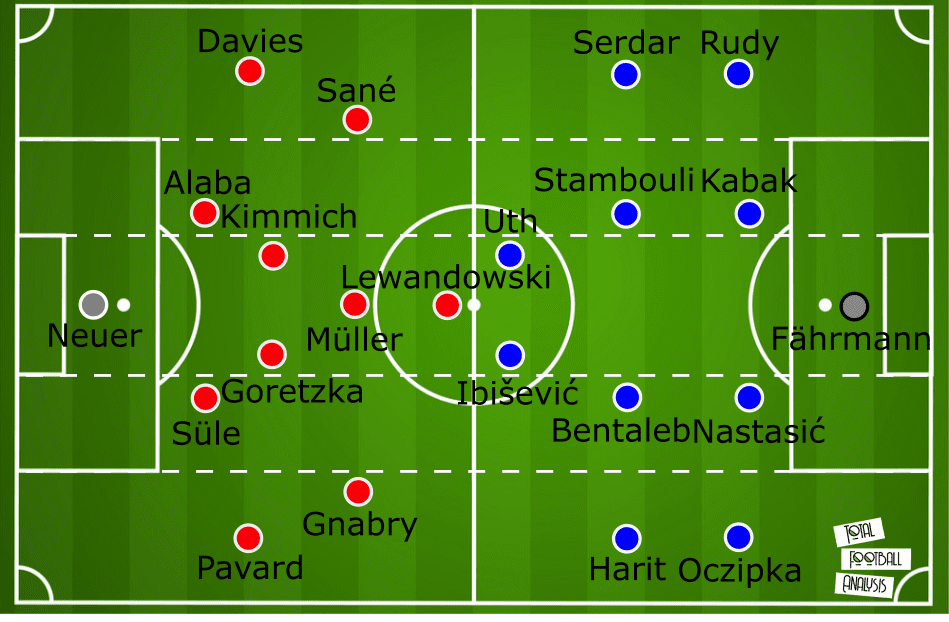
Bayern Munich (4-2-3-1): Manuel Neuer; Benjamin Pavard, Niklas Süle, David Alaba, Alphonso Davies; Joshua Kimmich, Leon Goretzka; Serge Gnabry, Thomas Müller, Leroy Sané; Robert Lewandowski.
This predicted Bayern line-up is very similar to their regular starting XI last season, barring new signing Sané and the absence of Spanish star Thiago Alcântara. Neuer made considerable improvements on his 2018/19 season last year, where he went from a decidedly poor shot-stopper, into a more than capable pair of hands in between the sticks, and this sees him begin his ninth Bundesliga campaign with Bayern. The defence stays relatively the same, albeit Süle will return from a prolonged injury hiatus. Given the speculation around Thiago’s future at the club, Goretzka will likely come in to accompany Kimmich in midfield. Sané is expected to enter the starting XI straight away against his former club, on the left wing, the position he made his impact for the Citizens. The rest of the forward line is expected to be the same as their last fixture.
Schalke (4-4-2): Ralf Fährmann; Sebastian Rudy, Ozan Kabak, Matija Nastasić, Bastian Oczipka; Suat Serdar, Benjamin Stambouli, Nabil Bentaleb, Amine Harit; Mark Uth, Vedad Ibišević.
The predicted Schalke line-up will certainly be different to their typical starting XI last season, due to returning loanees or player sales. Alexander Nübel is one such sale, and it is being predicted that Fährmann will begin as the starting goalkeeper for Schalke this term. Jonjoe Kenny was the usual starting right-back, but he is back at Everton now, and it would be wise to imagine that Rudy will take up this position, as he has experience there in the past. The rest of the defence will probably stay the same. In a 4-4-2, it is imagined that Serdar will start on the right-hand side, where he has gathered some game time previously. Bentaleb returns from a mixed loan at Newcastle United and is expected to feature alongside Stambouli in the centre of the park. Harit will play as the left-midfielder, supplying balls into the box for new signing Ibišević and German forward Uth.
Bayern’s defensive posture
Bayern mostly use a 4-2-3-1, which becomes a 4-1-4-1 in a defensive posture. Kimmich anchors in front of the defence, while the other midfielder (usually Thiago) and the #10 align to create a man orientated band across the middle. Lewandowski will press the opposition centre-backs, while the wingers will push up, should the ball go wide. Bayern will also press in the wide spaces effectively, either by pushing the full-backs high on the ball side of the pitch, leaving an effective three at the back, while the winger and the midfielder push across to cut off passing lanes back infield. Due to Davies’ and Pavard’s athleticism, they can push up quickly. This, in tandem with the positional cleverness of Kimmich, ensures that with a kind-of back three, Bayern are rarely caught short if the ball meets the wide press.
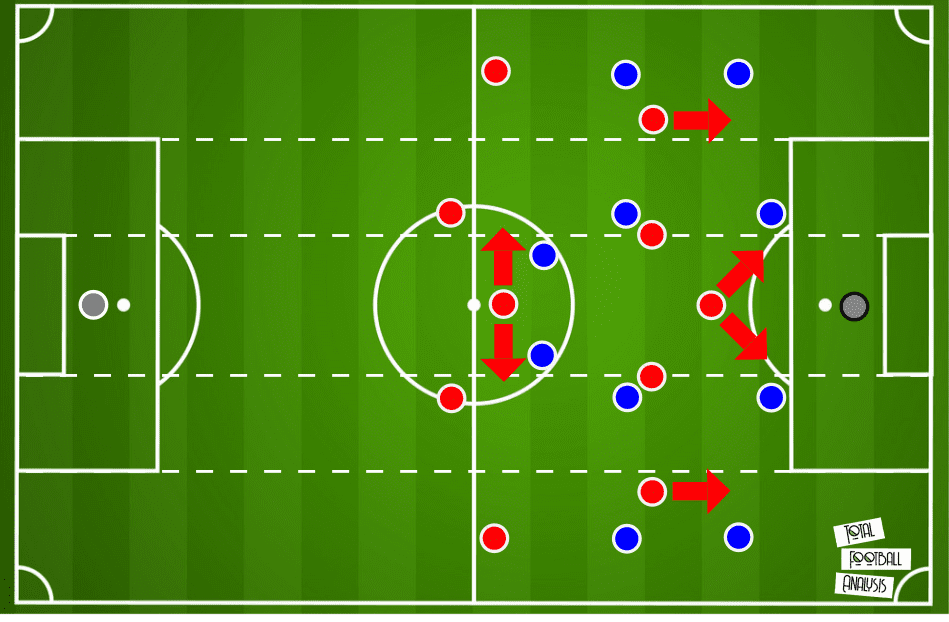
Versus Schalke, this should bring a strong degree of success, as the away side’s primary tool in the final-third is to attack the wide-spaces. Harit, Schalke’s best attacker and strongest hope of success, will likely be placed on the left-wing, up against Pavard. The Frenchman position’s himself in the less advanced positions than his Canadian counterpart on the other side of the pitch, meaning he is unlikely to be exposed defensively. One-on-one, Pavard is a capable defender, and while Harit is a tricky opponent, the 24-year-old should be able to deal with him competently. This is seen in his 54.8% tackle/dribbled past percentage, which ranked in the 88th percentile of full-backs within Europe’s top five leagues (with 10+ starts).
Davies and Pavard deserve further credit for how Bayern have added impetus to their attacks out wide. Flick likes to employ what could be described as a football’s bait-and-switch, by overloading one side of the pitch, often the right, before moving the ball promptly to the other. This allows the incendiary Davies to use his pace, dribbling, an eye for a pass, or shooting chance to find space to attack. He acts as an auxiliary winger in the attack, but with the pace and recovery skills to do his defensive duties ably too. His 0.15 xA, 3.63 successful dribbles, and 7.41 successful pressures (all per 90) resemble a complete full-back with plenty of room to grow still, which is frightening.
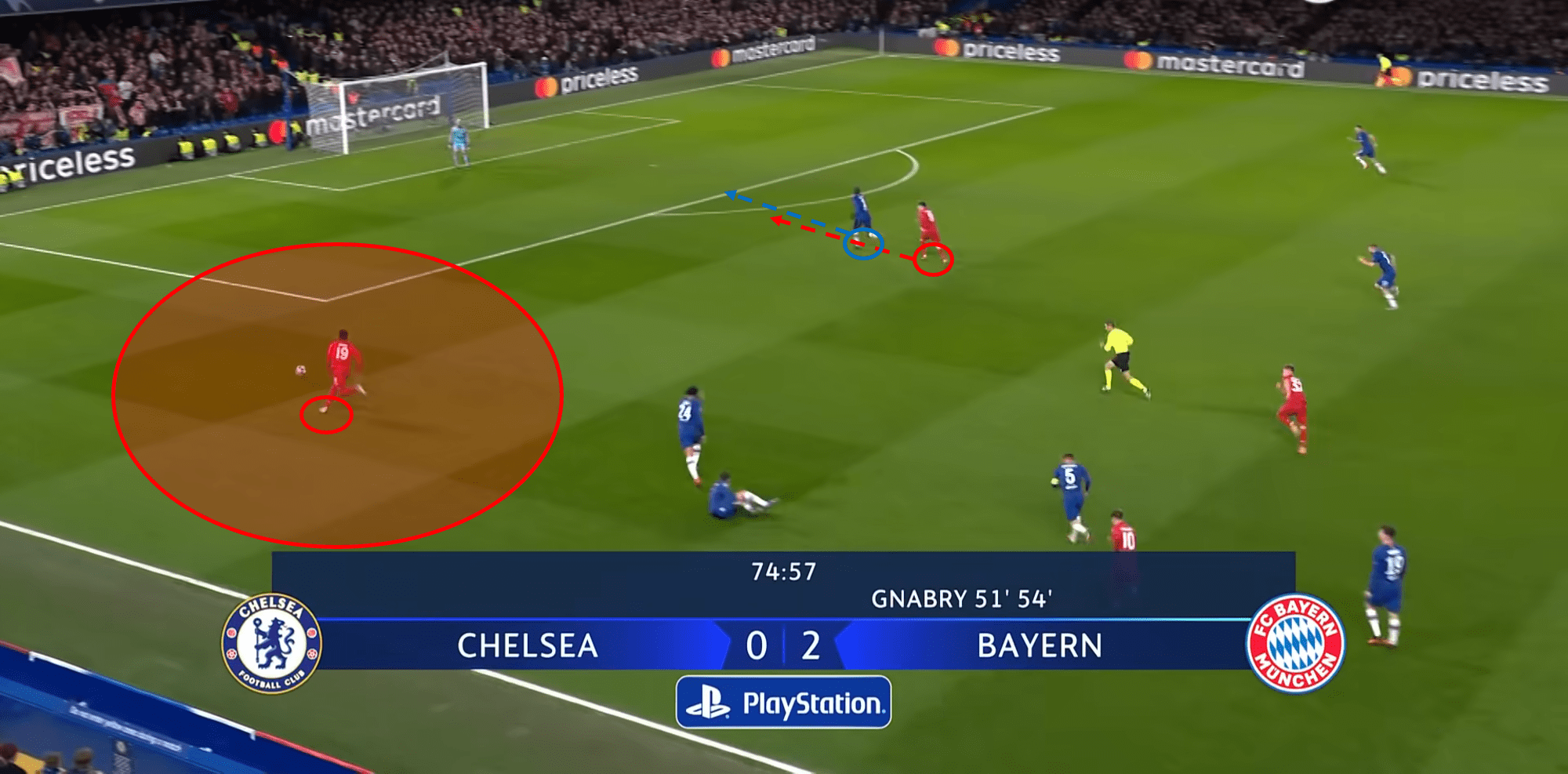
In the above analysis, we see Davies in an advanced wide position, after combining with his teammates to get into space. From here, he sends a low, driven cross to the feet of the lethal Lewandowski, who dispatches it cooly.
David Alaba, Davies’ left-sided defensive partner, has also been crucial at centre-back. While Kimmich drops off, Alaba has the freedom on the left to roam forwards with the ball and play pinpoint passes which break the opposition lines. He can also free Davies on the left, or even hit longer passes to the wide players, which gives Bayern a hugely effective deeper playmaker, as well as Thiago in midfield, compensating for the lack of an orthodox playmaking #10.
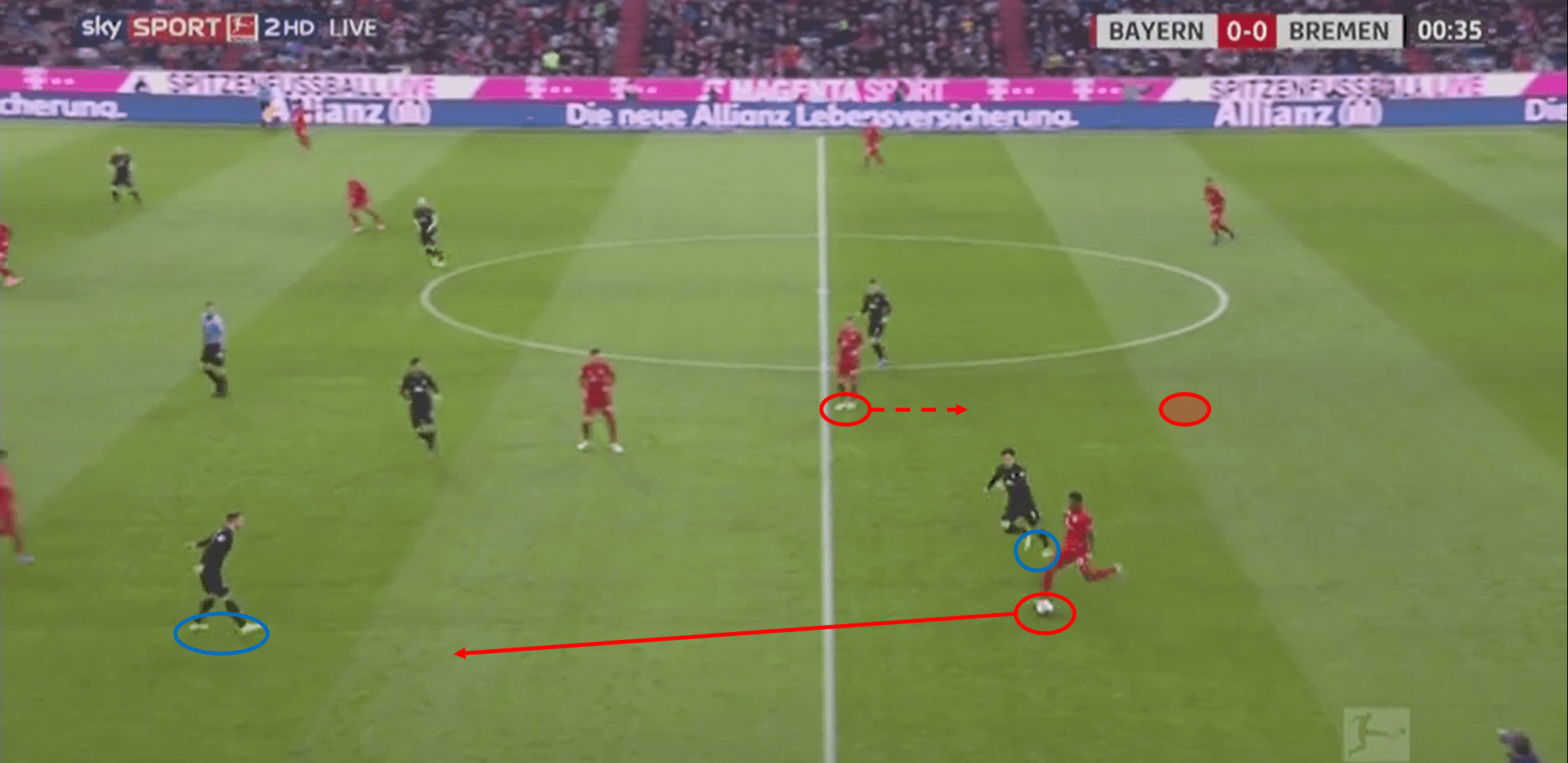
Here, we see Alaba begin to play a long-ball out towards the left-back Davies, who is making a run in behind. This is after the Austrian took on the Bremen forward one-on-one before going around him. Kimmich is in the position to drop-back and provide cover for the roaming Alaba.
Against Schalke, this should be very effective, as Wagner likes his attackers to press the man aggressively, while Alaba is very nuanced in bypassing this sort of pressure. As seen above, he can bypass this pressure via ably taking it round his man with clever touches sending the opposing player in the wrong direction. Even if the Austrian is caught out, Kimmich’s positional acuteness allows Bayern flexibility in their possessional approach.
Müller’s vital role as the Raumdeuter
In Müller, Bayern still have a player who can wreak havoc from the hole behind Lewandowski. Müller is able to be continually involved in starting attacking sequences and creating chances with aplomb due to him constantly finding space between the lines, taking the ball from Alaba or Thiago, or from out wide, and sending it immediately to another player in a shooting position. He lacks the dribbling ability to carry with much success, but he is fantastic positionally, and he is brilliant at linking play, as well as weighing in with eight league goals.
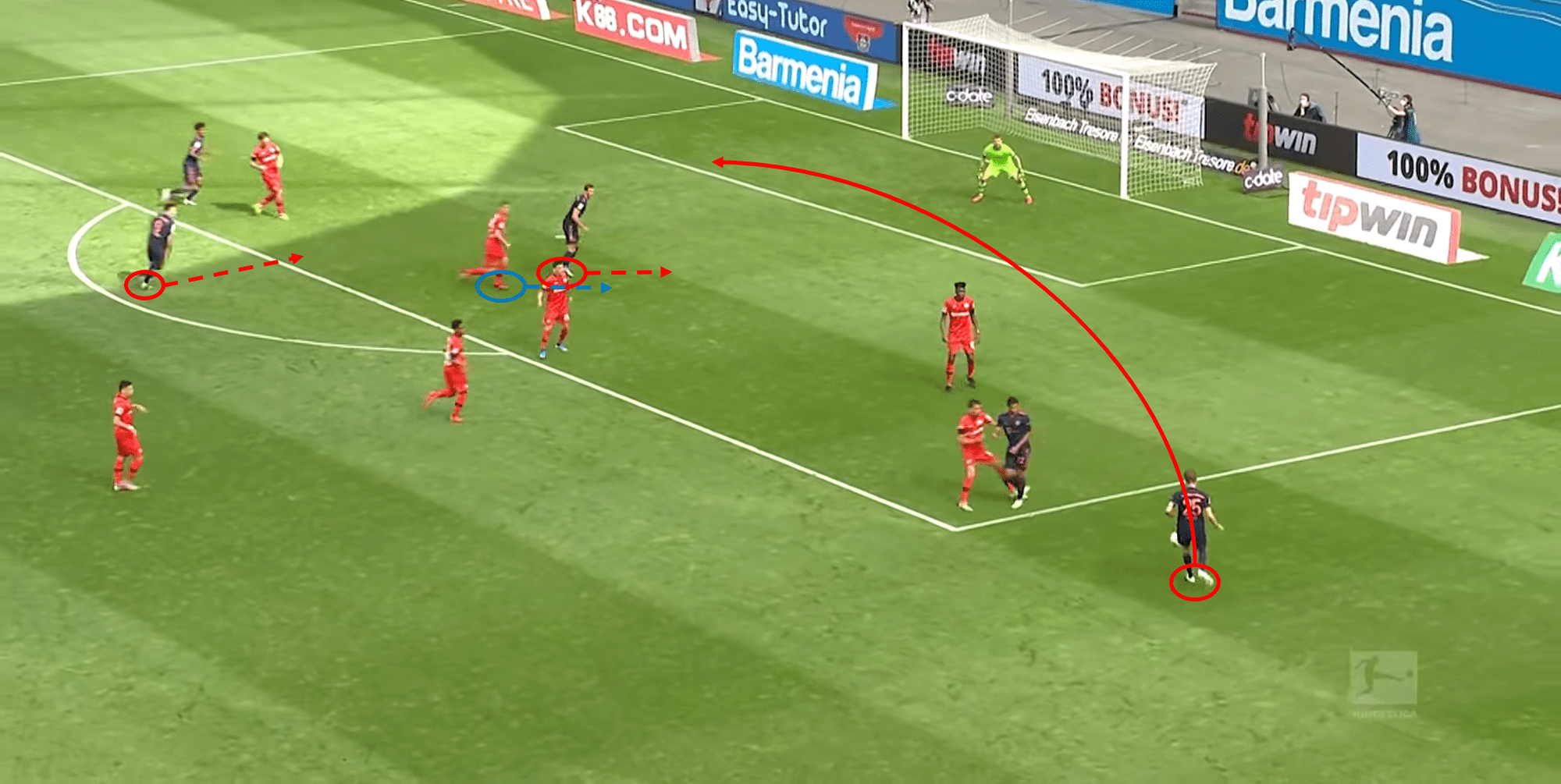
Occupying the right half-space, Müller is in the right place and the right time to pick up the loose ball. He does not look to carry the ball down the line, instead of sending in an instant lobbed delivery, straight onto the head of Lewandowski, who has space created by the diverging run of Goretzka.
Müller has played as a right-sided wide attacker, as well as in the hole. While Bayern like to attack the wide areas, they have also improved in working the ball in tight spaces centrally, where Lewandowski can drop off, Gnabry or Coman cut inside, and a midfielder pushes up to create an overload centrally. As a Raumdeuter (translated to mean ‘space interpreter’), Müller is an extremely important player for Bayern in the attacking third. Müller likes to drift into areas where he can create overloads for his side such as the half-spaces or even the wing. Therewith he opens up space for attacker Lewandowski or the wingers who then move inside.
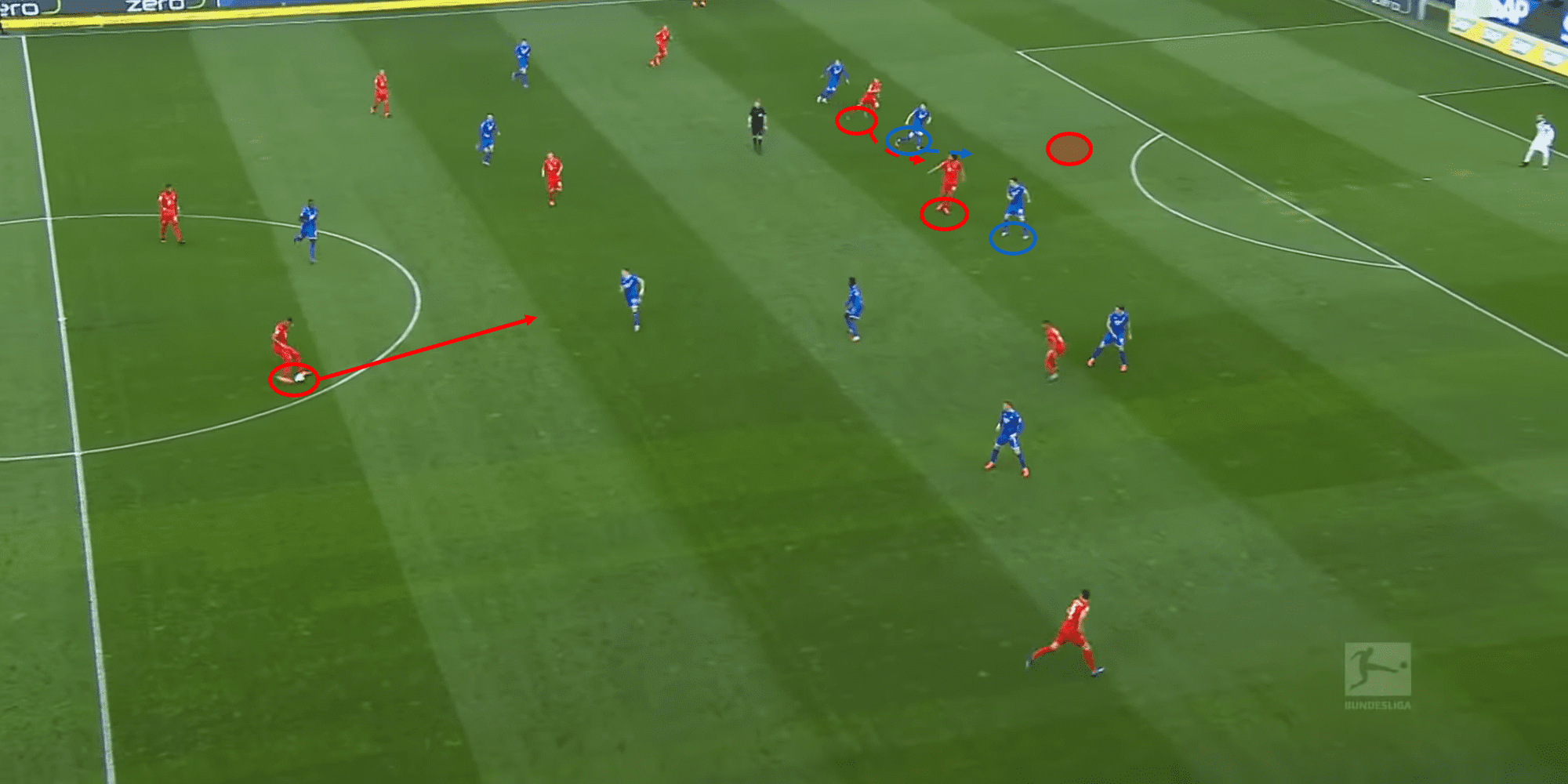
In the above analysis, we see Jérôme Boateng look to play the long ball towards Hoffenheim’s box. Müller makes an angled run inside to collect the ball to the feet, then immediately offloading the ball to a fellow attacker.
Due to Mascarell/Stambouli’s frequent positioning as a supplementary centre-back and the high positioning of Schalke’s other central midfielder, Müller should be able to occupy these positions with space to spread the play towards another Bayern attacker to a fruitful return. With two wingers who are encouraged to make runs in behind, it is important for Müller to call for the ball to feet regularly, so as to create a dynamic attacking unit.
Wagner’s intense pressing game
Schalke typically line up in a 4-2-3-1 formation, with an attacking midfielder and two wingers playing off of a lone striker, which was most frequently either Benito Raman or Guido Burgstaller. They have also experimented with a slightly modified 4-4-2 shape, which saw the likes of Ahmed Kutucu and Mark Uth get a chance, allowing for a more direct form of attacking, with two tall, strong strikers to target with long balls. Their high pressing activity is seen in their pressure league ranking, where they rank third in the league for attempted pressures in the final third.
Wagner has built his coaching reputation on an intense pressing game and remnants of this have been seen in his time at Schalke. Defensively, he sets his side up in a 4-4-2 and his front two are tasked with closing down opposition centre-backs. Burgstaller is a hard-working centre-forward and as such, Schalke saw immediate but brief success with this style of approach. In the press, he usually partnered with Harit, with whom he both pressures centre-backs and blocks off passes into central midfield. This man-to-man pressing is continued in the middle of the park, usually with the now-Juventus man McKennie pushing up the close down the opposition’s deepest midfielder. When McKennie moved forward to support the press, Mascarell stays deep to cover the space in behind.
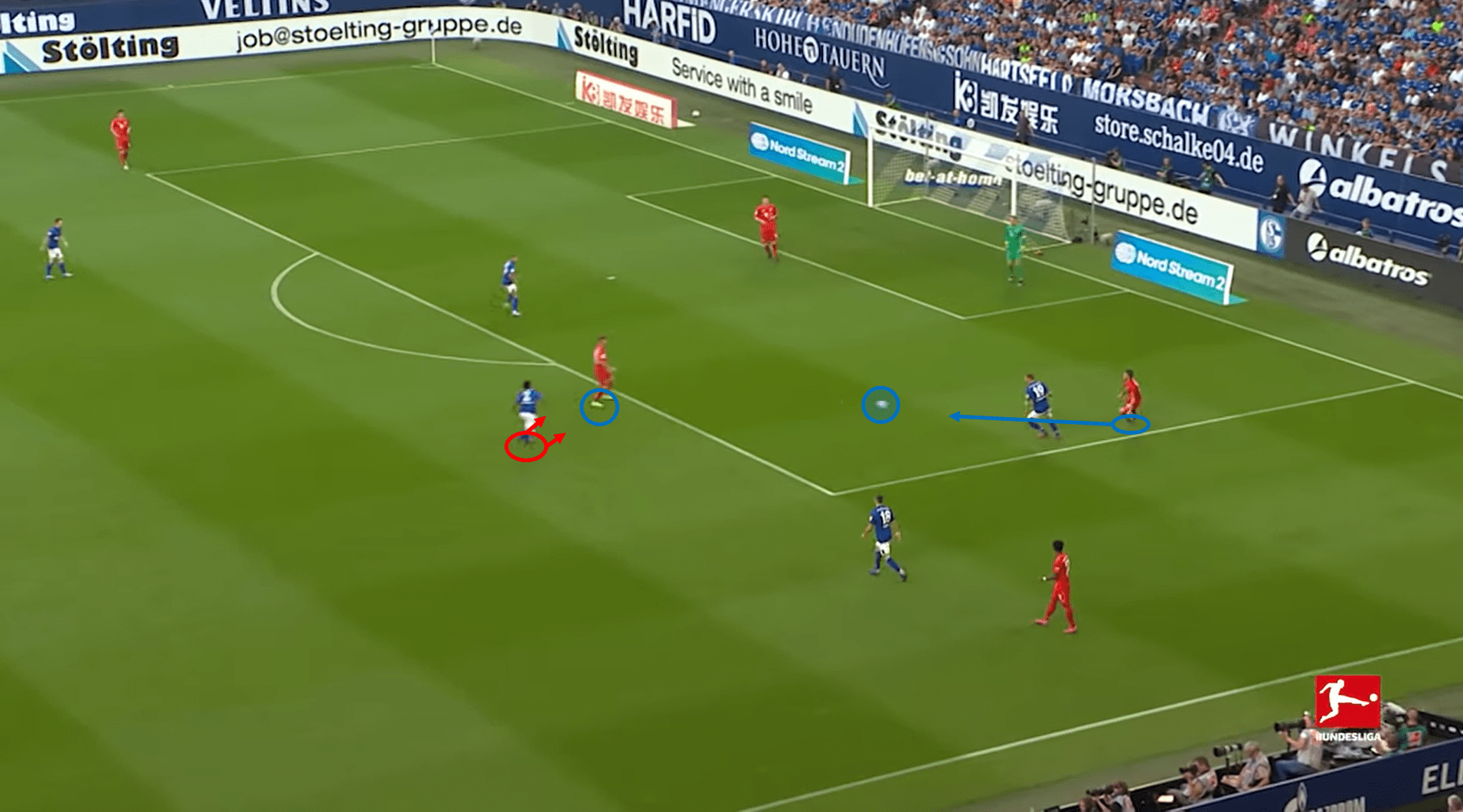
Above, we see a pass being played between two Bayern defenders. As soon as the pass is played, McKennie is pressing the receiving man instantly, while Mascarell would stay back to cover the space.
In possession, Bayern have numerous passing options available, and Flick’s men are entirely capable of bypassing this pressure by completing an aforementioned bait-and-switch or via simple combination play. In the example above, Kimmich is facing towards the goal and has both Süle and Neuer as passing options, either of which could play a lobbed ball into midfield to bypass the pressure and exploit the space left by the American.
Schalke look to manipulate opposition possession into the wider areas, while their wingers look to close down the opposing full-backs, and the adjacent central midfielder will move up to cover the pass back inside and keep the opposition wide. This pressing activity initially made Schalke much tougher to break down. In the second half of the season, Serdar, Harit, Mascarell, and Sané all picked up injuries – players were seemingly dropping off like flies. These players were vital to Schalke’s intense pressing game, while their replacements were not adequate enough or accustomed to Wagner’s style of play, meaning that the Gelsenkirchen were much easier to break down.
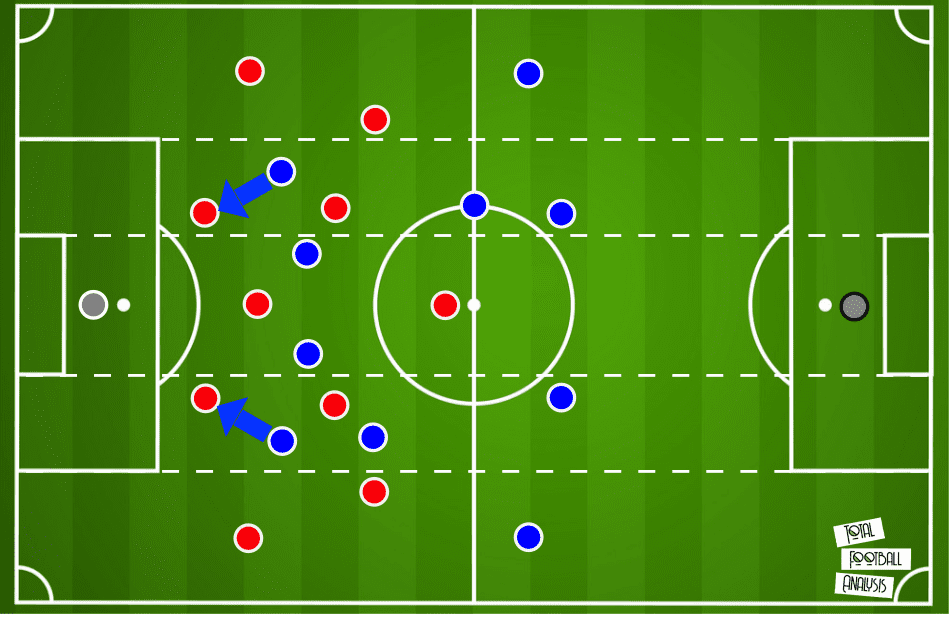
Mascarell and Sané are two players who are still out through injury, but the return of Serdar and Harit especially will be welcomed by Wagner, who will be hoping for a similar performance by Harit against a top Bundesliga side, ideally similar to his game away to RB Leipzig, where he contributed a goal and an assist.
Schalke’s variety in attack
Wagner’s side initially were also a varied attacking outfit, who were able to hurt the opposition in several different ways. One way was to play through the opposition, which was made possible by the number of options that Schalke had in between the lines. Mascarell regularly dropped between or to the sides of the centre-backs, creating a back three, to give Schalke a numerical advantage when building out, making it difficult for the opposition to press.
His deep positioning allowed Wagner’s full-backs to occupy high and wide zones on the field. This is because the full-backs were expected to provide attacking width, on the right they had Everton loanee Kenny, who brought industry, pace, and commitment, while on the left, Ocipzka offered an outstanding crossing ability. They stretched opposition midfield lines, allowing wingers Caligiuri and Matondo to come inside and exploit opening space in the channels to get on the ball, turn and drive at the opposition’s backline. Though, this style of play in possession relied too heavily on the individual strokes of genius of players such as Harit or Matondo, who are both far too inconsistent to rely upon for an entire season, be it either due to injury or lack of experience.
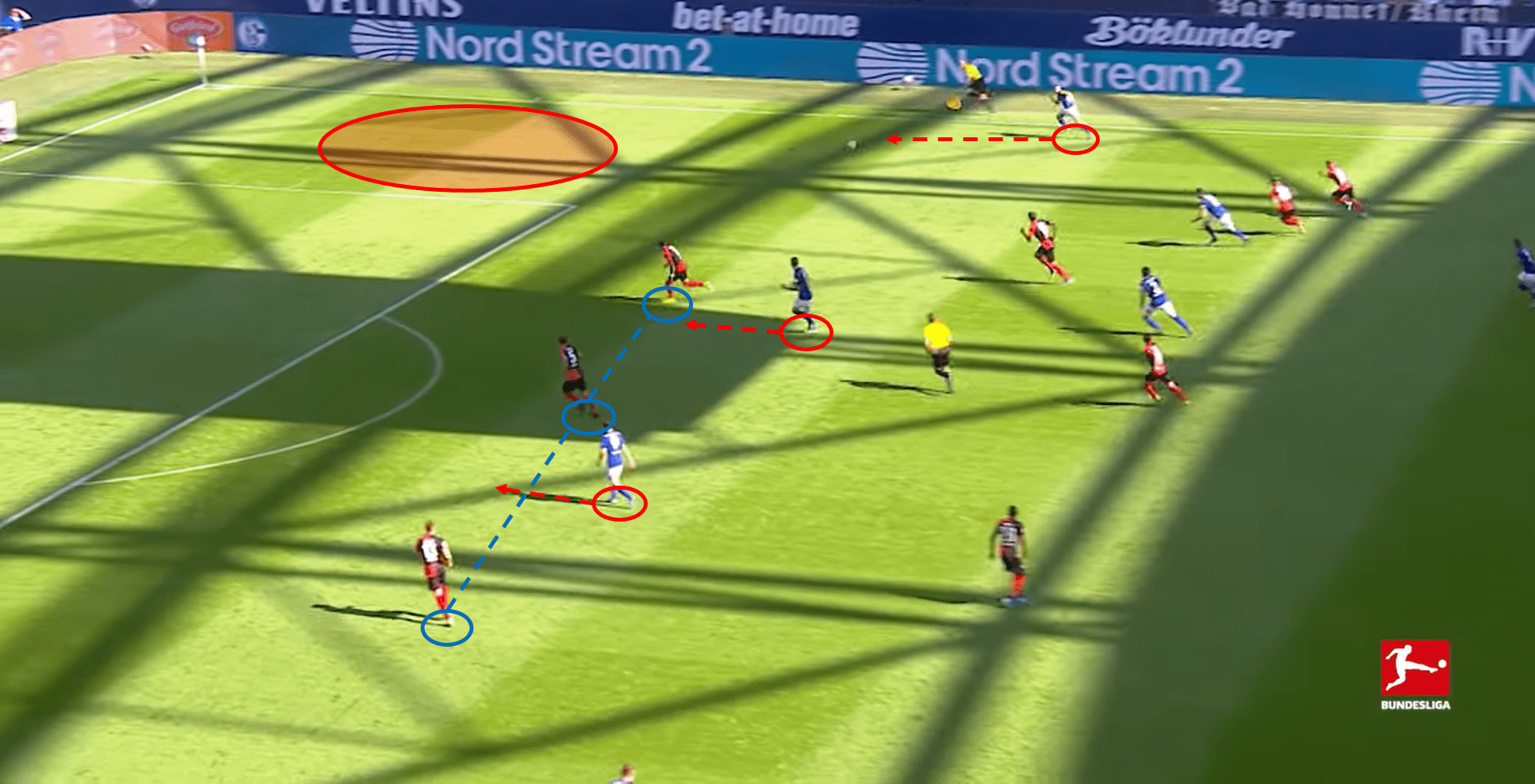
Above, we can see Kenny enter the final-third with plenty of green ahead of him to run into. With plenty of options in the box, he only has to pick out the right delivery for Schalke to have a good goalscoring opportunity.
Against Bayern, it would be very hopeful to expect brilliant individual performances from Harit or Matondo, especially the latter who is a notably raw talent, who needs to work on a few facets of his game. Kimmich, alongside his defensive partners, should be able to deal with Schalke’s attackers in this respect very well.
Schalke were also able to play around the opposition, Caligiuri and Raman would drag the opposition’s full-backs inside, creating space for Kenny and Ocipzka space to move forward into on the flanks. Once in these positions, the full-backs would play low, driven crosses into the penalty area for both wingers to attack. Alternatively, they used simple combinations between their advanced full-backs and wingers to progress the ball in wider areas. Harit, who also operated on the left-wing, was superb in these moments. He dribbled often when he was allowed to do so, at a 65.6% success rate, as well as providing a real goal threat.
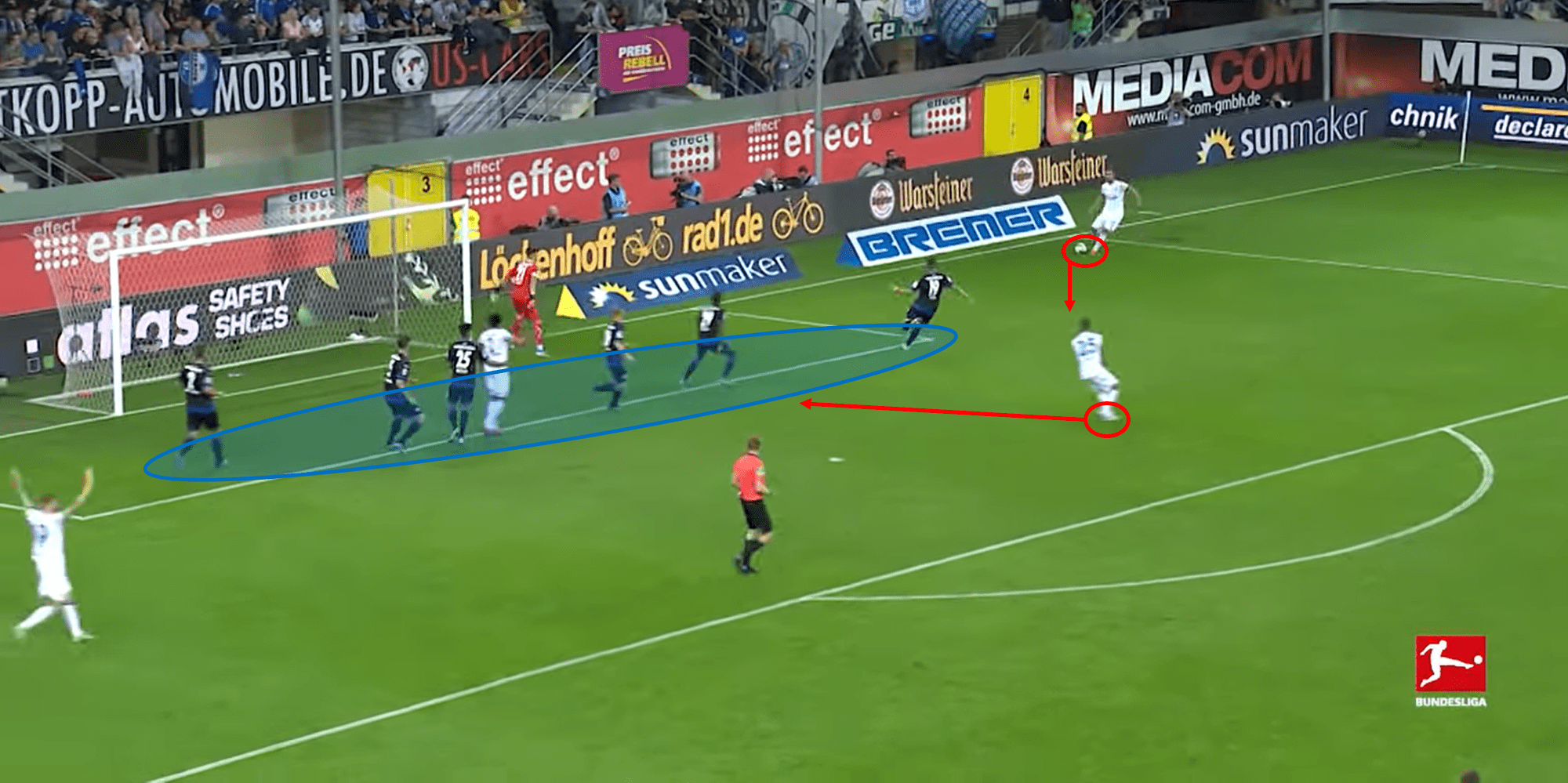
In the above analysis, we see Harit calling for the ball in the box after a switch of play. Due to the lack of defensive presence near him, he has the time and space to finish his chance into the bottom left corner.
Wagner’s side were also willing to attack more directly when appropriate. In these situations, short passes between the centre-backs, Mascarell, and Nübel (now a Bayern Munich player) were used to lure out opposing midfielders and open a gap which could be exploited via a long ball. Before the ball got near the goalkeeper, Schalke tried to press aggressively when attacks break down. The nearest player would pressure the ball, usually joined by one other, to rush the opponent in possession, while passing options were man-marked. Then, once the ball is regained, Schalke counter-attack quickly, with plenty of forward runners seeking to take advantage of the space available in transition.
Due to Bayern’s defensive posture and talented individuals, it is hard to see Wagner’s side find any success through these attacking ventures. Schalke’s best hope would be to target the spaces left open by Davies whenever he roams forward. If Schalke were to overload the right channel, they could combine via a wing rotation to create a crossing opportunity into one of their taller forwards. This could be seen as Schalke’s greatest chance of success in an extremely tough game.
Final Predictions
What does all of this mean for the upcoming Bundesliga tie? Schalke finished the 2019/20 season in emphatically dreadful fashion, and they are still missing a couple of important players, namely Mascarell and Sané. It is hard to see an outcome which would be positive for Wagner, with their only hope being to expose Davies defensively, due to this high positioning. For Flick, he will expect his side to turn over a poor Schalke team, and for them to continue their exquisite form which won them so many accolades last term. The introduction of Leroy Sané should only add to their already world-class attacking unit, giving his former employees plenty to consider in the final third. My final prediction would be a 4-0 victory for Bayern Munich.





Comments